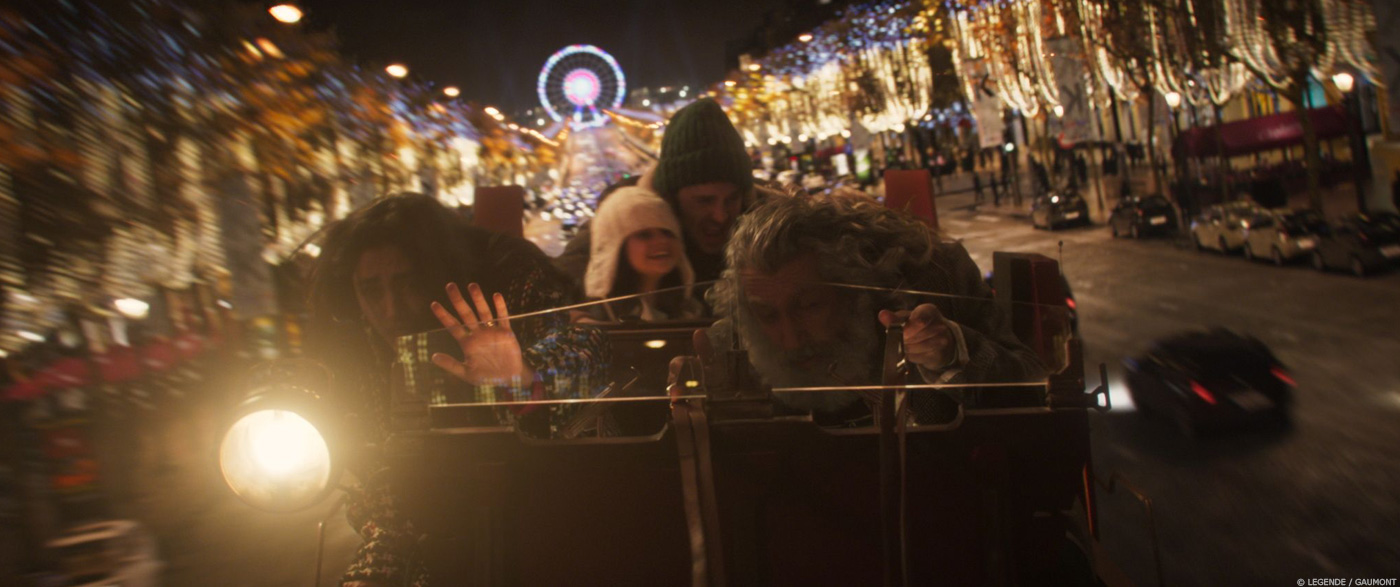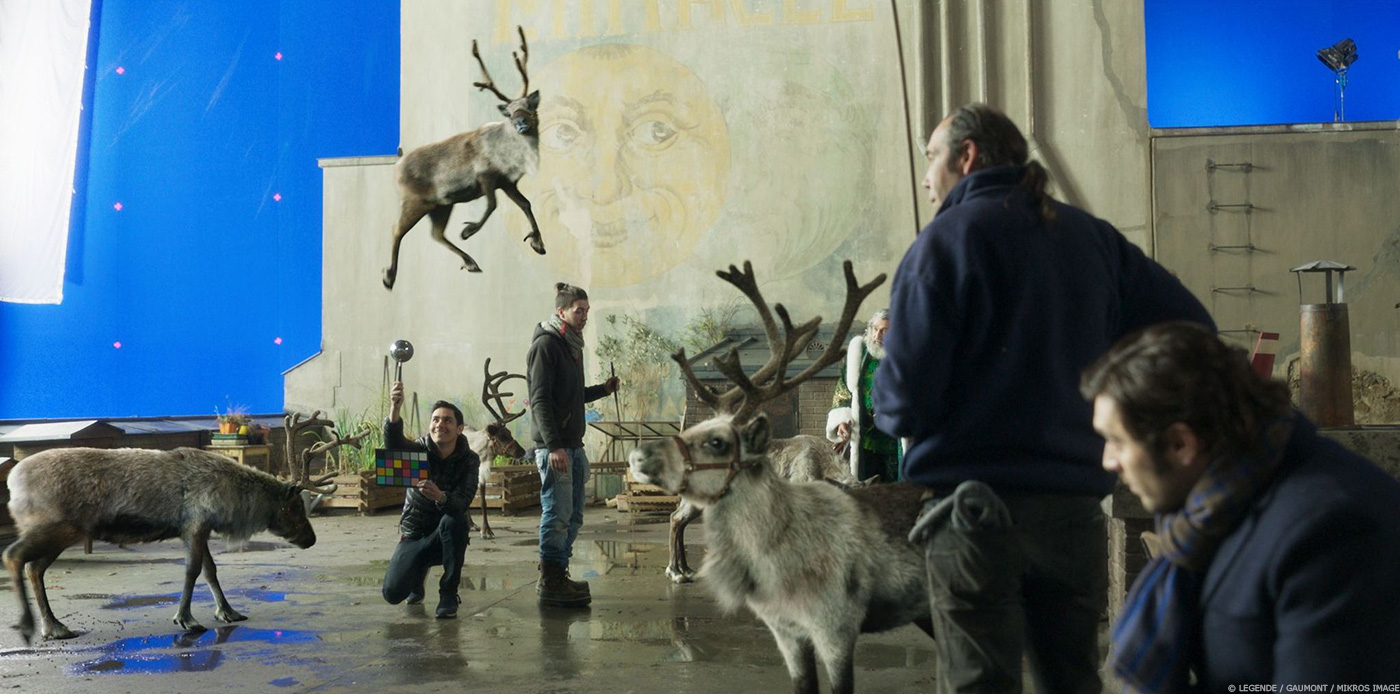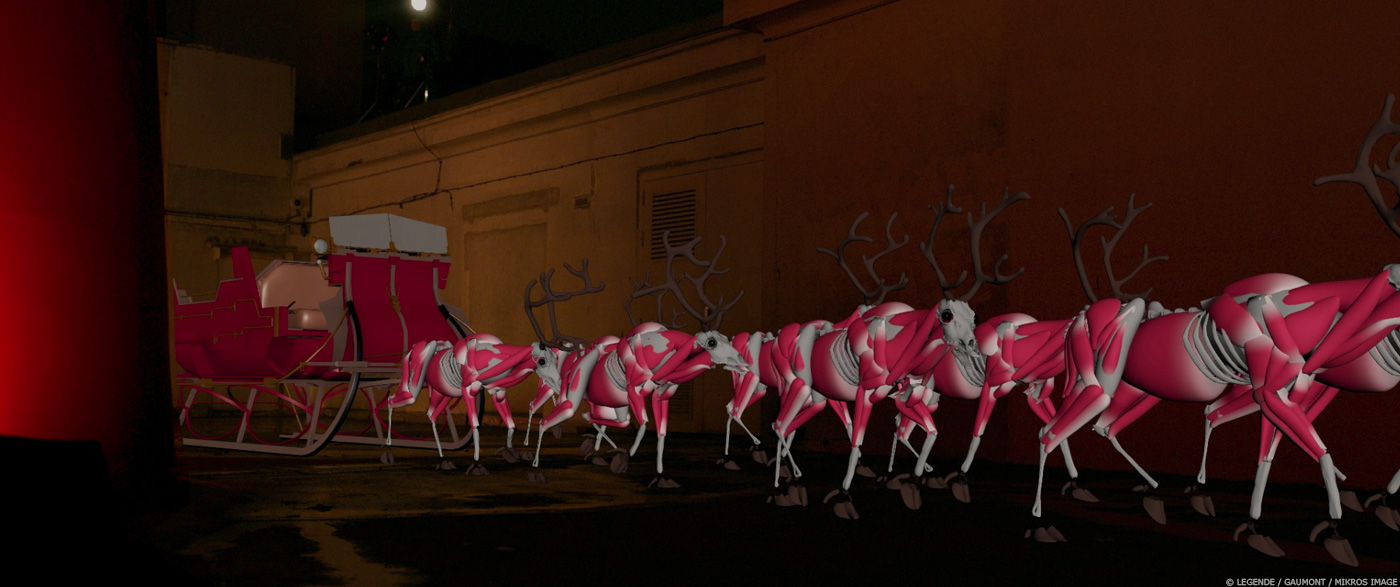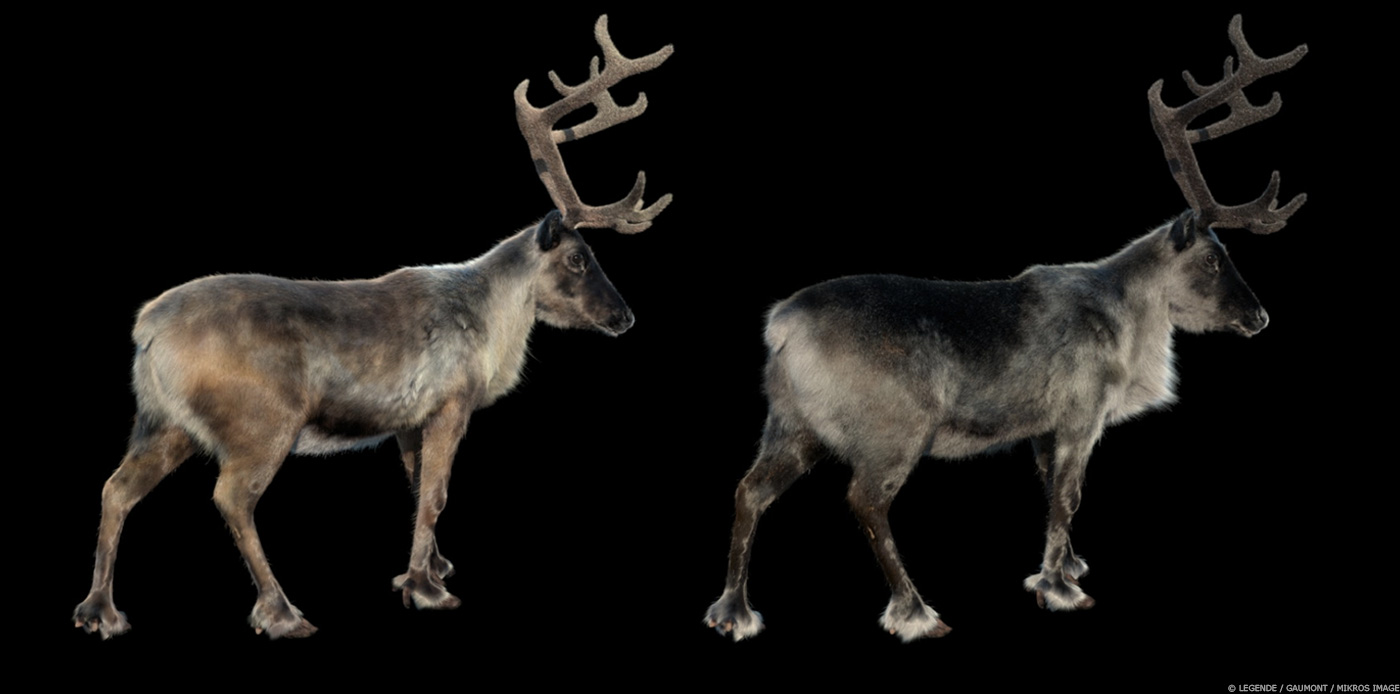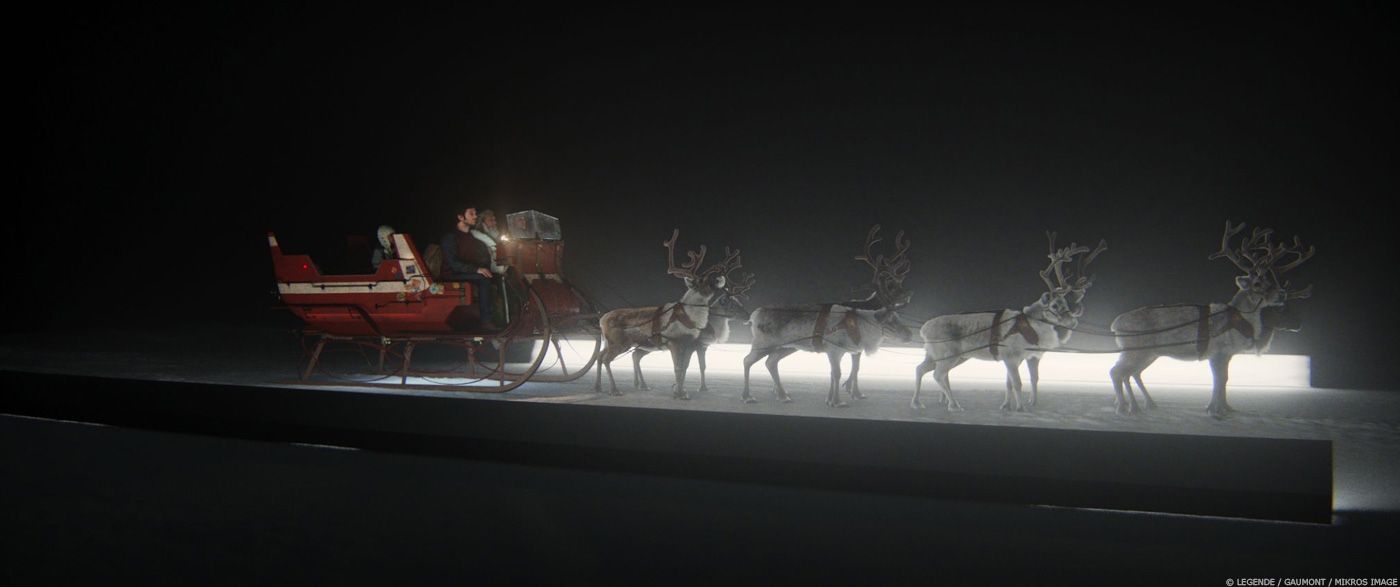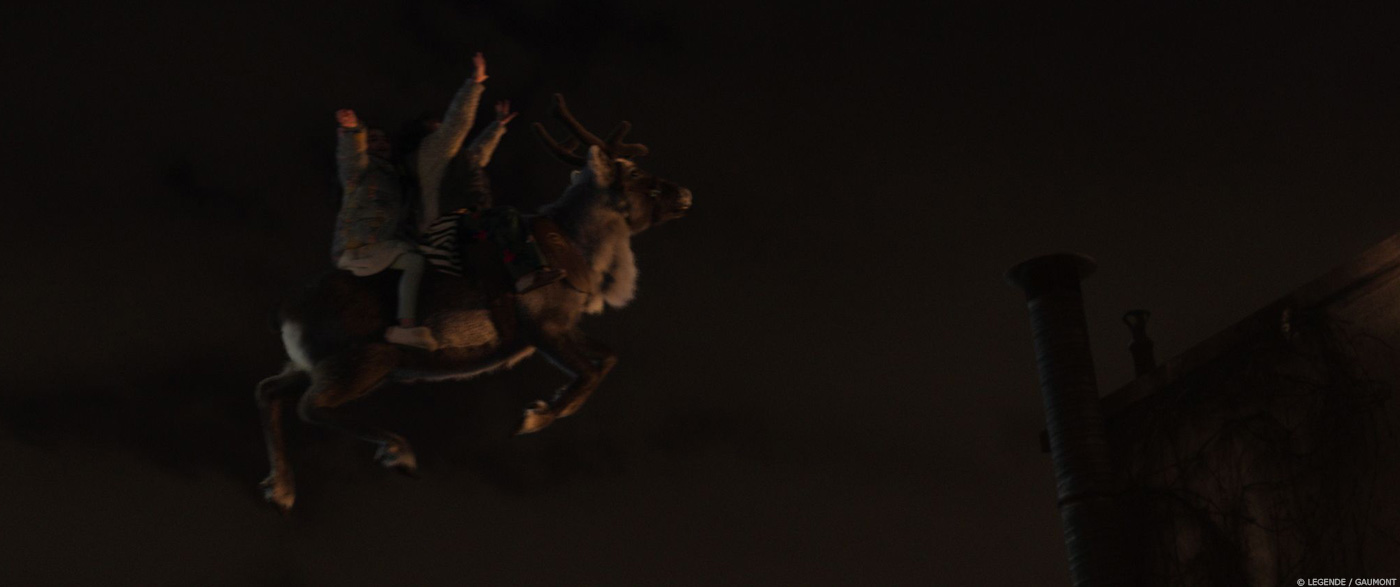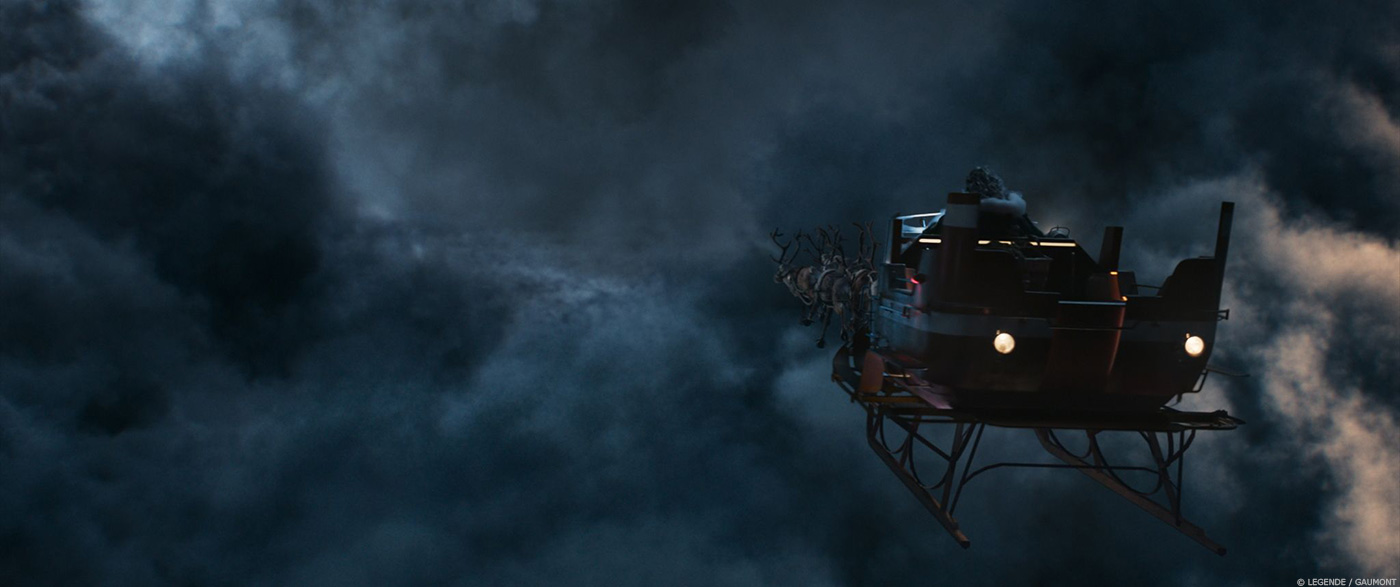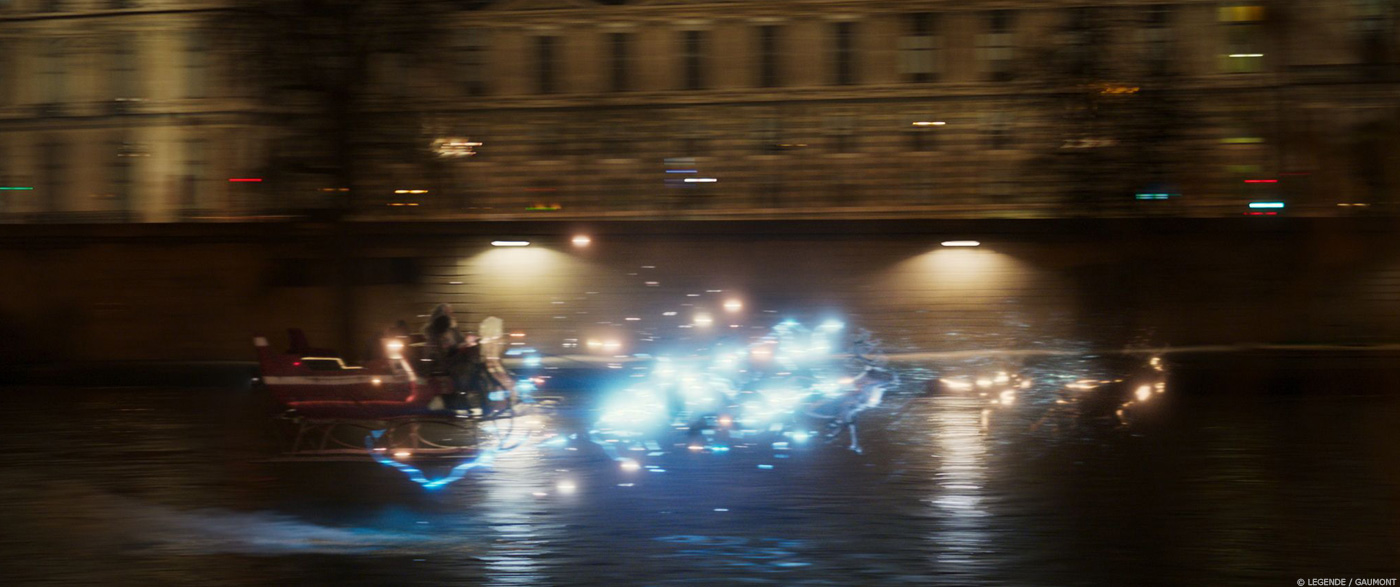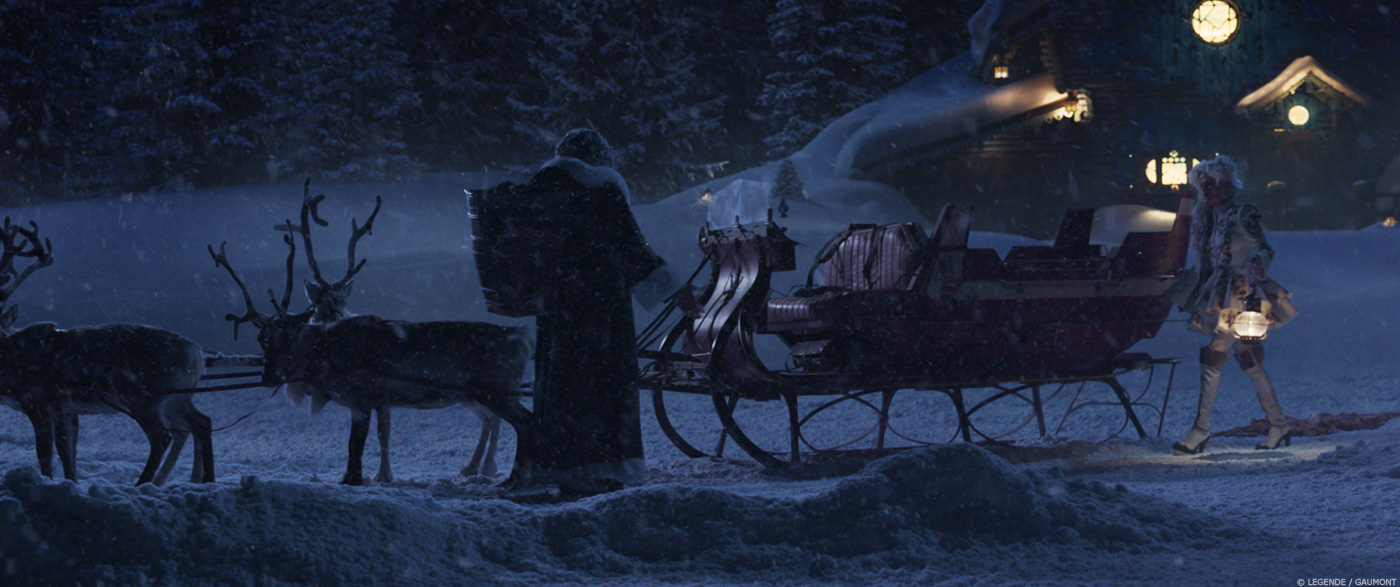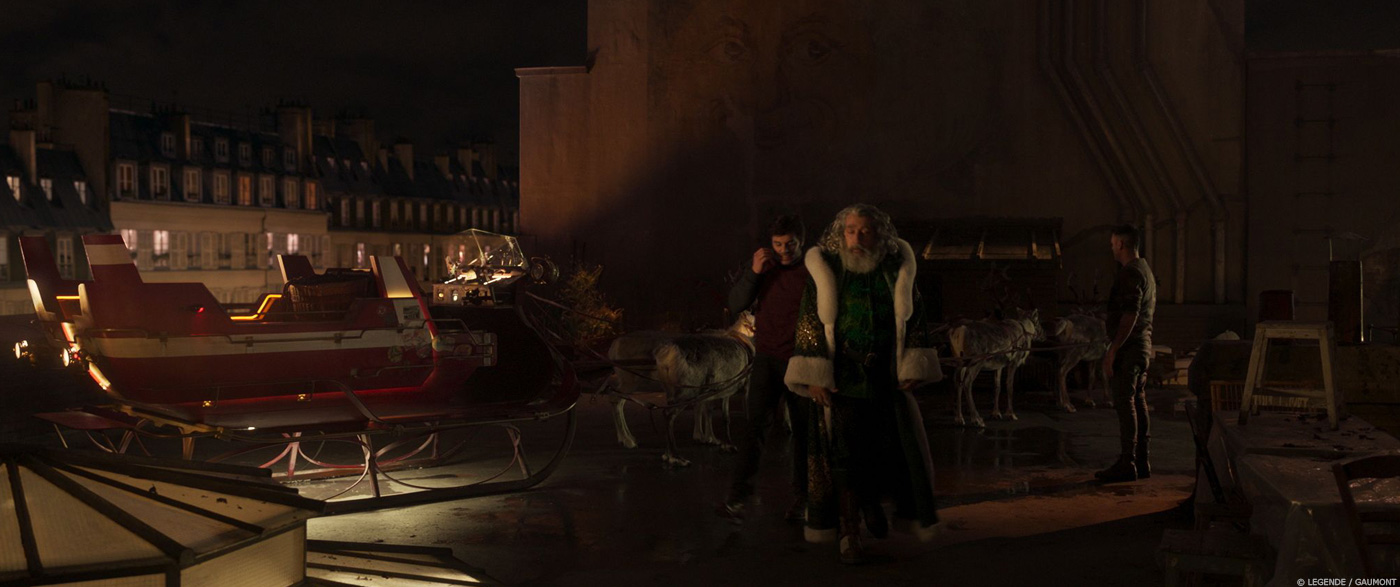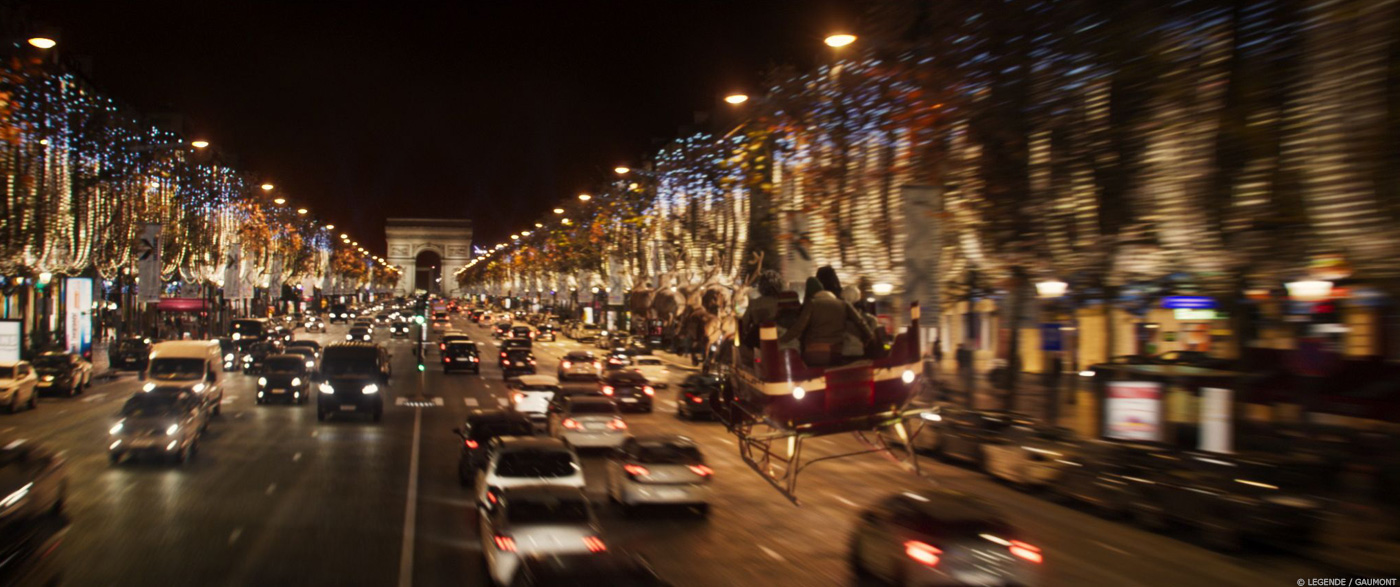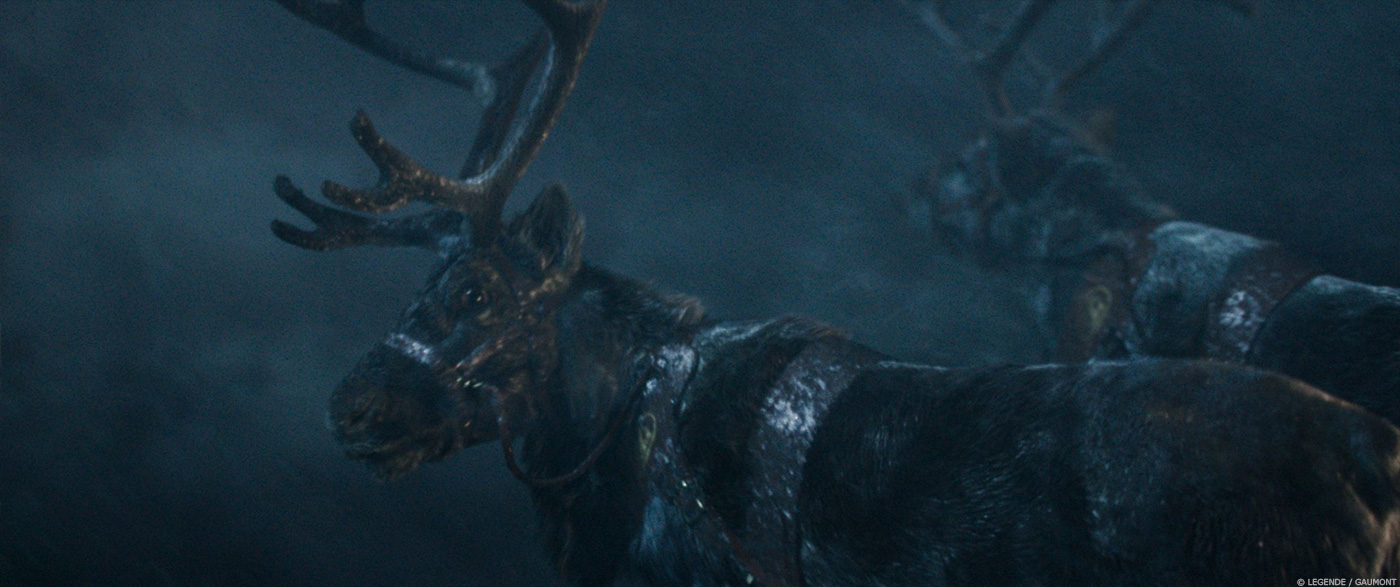Hugues Namur is working in visual effects for more than 20 years. He is VFX Supervisor at Mikros Image since 2002 and has taken care of the visual effects of films such as ASTERIX AT THE OLYMPIC GAMES, PARIS 36, THE BURMA CONSPIRACY and CHOCOLAT.
What is your background?
I always was interested on CG, but at the beginning of the nineties you had very few opportunities to access the softwares and equipment required, so I started working as a matte painter for commercials and next had a chance to learn Maya when it was released. A few years later, I collaborated with Mikros Image as comp supervisor of the Paris Big Wheel destruction scene in a French action-comedy. It’s funny because this ambitious VFX sequence – at the time – was already taking place in the Champs Elysées, 15 years before SANTA & CIE! Afterwards I became part of the permanent staff in 2005, and started working as VFX supervisor for feature films.
How did you and Mikros Image get involved on this show?
The production was looking for French studios to handle the VFX of the film, and contacted Fred Groetschel, executive producer at Mikros. I had to read the script and produce a ballpark very quickly, which made me immediately very motivated. As the production hired Bryan Jones as VFX overall supervisor, I knew we wouldn’t be in touch with the director as usual – but I already was used to this when working on previous big budget films with Christian Guillon in France.
What was your feeling about this first collaboration with director Alain Chabat?
Very few French directors are used to massive use of VFX, and Alain is definitely one of them, so the team was very enthusiastic about this collaboration. We visited the set a few times to capture specific material, and took profit to review WIP assets with Alain. His comments were always very positive, and we could talk about the furtive mode and attached references from 80’s cult movies, for example. Alain came to visit the team during production and that was a great moment, he showed interest for every department, asking the animators about the way we have the reindeers flying, checking the poster ads displayed along the Champs Elysées… I think Alain was happy with our work.
What was his approach and expectations about the visual effects?
We knew Alain didn’t want the reindeers to feel cartoony. I guess he mostly relies on the story and the situations to provide the fun, with no need of exaggerating things (his own character is mostly phlegmatic). Nevertheless, he might require 2D non-realistic tricks to provide the right gag in some occasion: for example the last shot of the storm scene, when Santa and the sled suddenly falls down, is totally rebuilt in comp and is deliberately cartoony.
How did you work with Production VFX Supervisor Bryan Jones?
We had a first meeting with Bryan and VFX Producer Pierre Procoudine based on the script and some story-boards, and we could make sure we were on the same page regarding how the effects would be achieved, what would be shot practical and how to make sure we could deliver with the tight schedule we had: of course, delaying the release of the movie after Christmas time was not an option! Once we started to process the shots with the source files, we had a weekly review with Bryan and Pierre every Wednesday which many times lasted more than four hours, with animation, CG and comp separate playlists. We liked very much these reviews, where we occasionally invited the animation supervisor Alexandre Sauthier, probably because we were all having a great fun with these shots, even when it became intense in the last two months. The day after the review, Bryan was showing the shots to Alain at the edit and then was providing feedback before the end of the week, sometimes quoting Alain’s encouraging comments.
What are the sequences made at Mikros Image?
We were assigned all the effects involving the reindeers. Basically, even the real reindeers on set needed VFX because their antlers were too small when we were shooting in February (it’s falling every year in winter). But of course the most important VFX job was to have them flying, pulling the sled and its passengers, travelling in the clouds, taking off or landing. Meaning we were also assigned every environments connected to the reindeers: Santa’s home, the storm in the clouds, the rooftop, the river and – last but not least – the avenue of Champs Elysées.
How did you organize the work at Mikros Image?
Reindeers scenes were scheduled first month of shooting, meaning we had to start the asset early to get approval on the design and the way to shoot some elements as soon as possible. Antoine Carlon, CG supervisor, built the reindeer asset with a small team and produced a series of line test. Meanwhile, the environment team led by Christophe Courgeau started the Champs Elysées to make sure we would be able to produce previz for the gimbal, planned at the very end of the shooting schedule. After receiving the first material from the edit we were joined by Eric “Janine” Lautard supervising the CG and Lucie Bories supervising the comp.
Can you explain in detail about the design and the creation of the reindeers?
At the beginning, we didn’t know many real reindeers we would have on set, but we knew we would need at least two or three of them to achieve close-ups and save on the VFX budget. A few weeks before starting the shooting, we joined Bryan to visit a park near Paris with tamed reindeers and could take stills and videos of one of them. This material was very important because it’s more difficult to produce a CG replication of an animal that is intended to play alongside its original. We asked Thomas Haas, our character designer, to refine the head of our first CG reindeer and it came to a point where I could almost recognize the specific reindeer I shot in the park. Soon after that, the ‘daylight rooftop test’ was probably the most significant step, where 3 out of the 5 reindeers wandering around Bryan holding the chrome ball are CG and could hardly be detected as fake – except the flying one, of course!
How did you handle their rigging and animation?
As the hairs are short on some part of the reindeers, you can feel muscles filling the legs and keeping certain volumes mostly constant when galloping or making leaps. Starting with an anatomic skeleton, we attached muscles in Maya and used them for every close-ups or sophisticated action – landing on the Moulin Rouge rooftop for example. In the neck and shoulders area, we also placed a jiggle controller to simulate the inertia of the flesh.
Can you tell us more about their fur and skin?
The fur of the reindeers was managed by Boris Kaufmann using Yeti, and rendered with Arnold with our specific pipeline. It was very important to replicate each of the real reindeers on set specifically, so we adjusted the colors but also the length of the hairs or the shape of the antlers. Nothing is perfectly identical in wildlife – even twins – and human brain is very sensitive at detecting repetitions as artefacts.
How did you create Santa’s sled?
We took reference on the practical sled designed by the production, and built our CG one based on a photogrammetry. But with the CG sled came the CG doubles of every actors on board. All were built based on material provided by 4dMax and, considering they would be moving fast or far enough from camera, we focused on animation and dynamics rather than fine details. In the storm scene, as we mostly keep close to the real Santa, we kept the practical sled and only added the bottom part of it with the skis.
Did you receive specific indications or references for the flying sled and reindeers?
Bryan produced animatics showing what speed and what kind of motion was expected. But there was no specific visual reference about the way the flying reindeers move their legs and body, and most of the thing we could find from previous films looked very cartoony. Which was not an option because – as much as possible – we had to match the real animals we had on set. Bryan and Alain had in mind the reindeers should rather move as if they were in the water instead of galloping in the void. So we ended with these giant leaps at full speed, and a kind of gentle swimming when they float above the rooftop of the kids building.
How did you work with the stunt and SFX teams especially for the reindeer gimbal?
The gimbal sled was animated real time with an operator, but the partly built reindeer was just mounted on a rotating plate – I guess the idea was to keep the set-up as basic as possible for the kids. As we had no motion control on set, the previz we provided were mostly considered as references, showing what kind of result we could get depending on a certain lens or camera move. The storm scene required a huge amount of water being thrown on Alain, who ended completely drenched after only two takes! Managing a blue screen through rain drops is always a little more difficult but it provides a very realistic feeling at the end. Same thing with the snow falling over our CG chalet when Santa’s leaving home at the beginning of the film. The way the practical snow flakes interact with light is very specific and it’s great to have it.
During his flight, Santa’s is confronted to a massive storm. How did you handle these FX elements?
The clouds environments are a mix between matte painting in the distance and CG clouds around the action. We firstly produced mood boards before splitting the task between DMP and FX, which were done with Houdini and rendered with Arnold. The cut for this scene was initially much longer – almost 50 shots – and when it was reduced the edit decided to use a long single shot to move from nice sunset to the storm. Finding the right balance between these two opposite weather conditions in the same shot was probably the most difficult in that scene. Not to mention that, inside the storm, the reindeers needed a specific fur design to look as drenched as Santa and were interacting with FX raindrops to complement the SFX.
Santa’s have a stealth mode for his sled. How did you design and create the effect?
We had a talk on set with Bryan and Alain about this effect, which is clearly referring to the Time Machine materialization in BACK TO THE FUTURE with lightnings and flashes. We asked our motion graphics team to provide a concept design using C4D and Particular before building a real asset with Houdini. The challenge was to adapt this design to different framings – close-up to very wide – and different durations – a few seconds to a few frames. We also had to keep in mind that this effect is a gag regarding the fact that it’s never happening at the right moment, meaning in several occasion we had to accept being a little less consistent but make sure the effect was comical.
We discover many environments. How did you approach and extended these locations?
Each of them has a specific story. Santa’s chalet must look real, but it’s a fantasy world in a fairy lighting. In that case we were provided 2D production designs that we tried to translate as much as possible in 3D volumes. We were later asked to extend the surroundings of the chalet with pine trees and snowy hills for the first shot of the movie and Santa’s coming back home at the end. As we already had the assets we could provide these new angles quiet fast.
The rooftop set was looking great and extending it was not so easy because it’s supposedly located in a 30 meters wide avenue, meaning we had a lot buildings visible in the distance. We built the extension based on a view from the former offices of the famous French daily newspaper ‘Liberation’, which was also used by production for shooting. The lighting was tricky also, because our background needed a subtle balance between the cold moonlight we had on the actors on foreground and the warm light coming from the street below.
Can you explain in detail about the huge Paris environment?
Rebuilding the Champs Elysées sounds like a challenge because it’s one of the most famous place in the world. Considering the action (flying above the traffic along the avenue) and reviewing the B-camera plates shot during Christmas time one month before the main shooting, we came to some conclusions. You have specific lights and ornaments decorating the trees and the alleys. This lighting comes in addition to the ordinary street lamps to produce a specific color balance that you can hardly alter. On the other hand, the illuminated trees are hiding the buildings so you don’t have to make each of them recognizable. And finally, the cars are very important because you’re flying above them and it’s finally the closest things you see in this environment. Of course, we had to adapt when we were told the sled would finally bounce to the trees and rip light strings!
Which one was the most complicated to create and why?
Definitely the Champs Elysées. We wanted to give the director the ability to adjust anything in the scene: the length of the avenue, its slope, the connections with adjacent streets, the amount of cars or urban furniture along the sidewalks… Everything would be editable in a semi procedural way. So we designed a tool in Houdini to do all that stuff and collected a bunch of particles with extra attributes (normal/orient/type etc..). Those particles were standing for each element we wanted to spread in the avenue, from trees to pavement layers, from parked cars to road signs. We finally collected the particle fields and the shaded props to spread them. It was like a big suspense the first time we pushed on the assemble “button” in Clarisse, but everything worked fine and after a few minutes of horrible wait we could fly over more than 1 km of heavy datas.
What is your favorite shot or sequence?
The close-up on the wet reindeer in the storm is one of my favorite, but I also like very much the Moulin Rouge landing: the reindeers are exhausted after flying through the storm and their legs are gliding on the ground, they almost collapse before stopping the sled and it’s a nice piece of animation.
What was the main challenge on this show and how did you achieve it?
The amount of complex shots was rather unusual, and the schedule to process them really tight. In such a situation it’s fundamental to provide the artists a strong support from production and coordination, and I should mention the quality of the production management conducted by Stéphanie Dubois et Simon Descamps.
What is your best memory on this show?
Well, we had a great team and reviewing the shots with them was every time a pleasure. When Alain came to visit us, we projected our WIP in our biggest screening room available with the whole team, and we took a few pictures in memory. It was quite moving for me because we don’t gather so many talented VFX artist on the same film very often in France.
How long have you worked on this show?
From the first meeting with Bryan to delivering the very last shot, almost one year.
What’s the VFX shots count?
We quoted more than 400 shots with the first edit of the film but it was finally reduced to 240.
What was the size of your team?
As the source files for the shots would be delivered only in the last 3 months before the final deadline, we scheduled up to 60 artists in August/September 2017.
What is your next project?
I’m currently working on the demos and breakdowns related to the show, and I’ll probably get some rest before starting a new project. But I’m already reading new scripts.
What are the four movies that gave you the passion for cinema?
Well, my father took me with him to see the first STAR WARS movie, first day French release! I remember being the youngest – if not the only – kid in the theater, and I had to go to school the next day. I remember spending the following years building all sci-fi model kits available and filming them with my dad’s super-8 camera, dreaming of motion control and blue screens…. Afterward I probably saw every SFX movies released in France and I remember being particularly amazed by CLOSE ENCOUNTERS and BLADE RUNNER. When I finally was allowed to see ALIEN many years later, despite the fact that I already knew every details about the story, creature and designs thanks to film magazines, I remember having been very scared!
A big thanks for your time.
// WANT TO KNOW MORE?
Mikros Image: Official website of Mikros Image.
Interview Alain Chabat about Mikros Image work
The Mikros Image team talks about SANTA & CIE
© Vincent Frei – The Art of VFX – 2017


